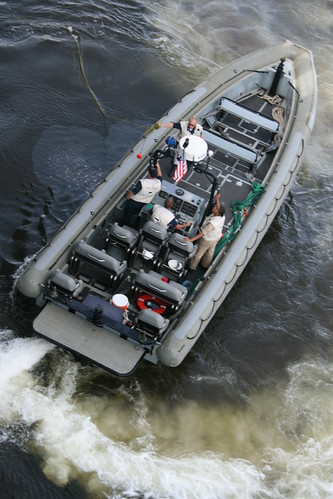Africa Handshake, Part Seven: Small Craft, Big Responsibility
With two expensive land wars draining the treasury, the Pentagon wants to prevent future conflicts without spending a lot of money. Two years ago the Navy launched its first, roughly annual Africa Partnership Station, sending ships on solo cruises up the West African coast to deliver training and humanitarian aid. The idea: to win new friends and re-assure old ones, and boost their ability to handle security crises on their own. Our own David Axe joins the landing dock USS Nashville for APS 3.0 in Gabon.
 They escort USS Nashville into port. They haul cargo: thousands of pounds of it. They ferry the commodore and her staff, plus the humanitarian and training teams, to their missions ashore. They’re training aids themselves, for teaching African sailors how to handle small craft. USS Nashville’s 11-meter Rigid-Hull Inflatable Boats, pictured, are the workhorses of Africa Partnership Station. In a sense, Nashville is just a floating hotel for people and a launch platform for the speedy RHIBs.
They escort USS Nashville into port. They haul cargo: thousands of pounds of it. They ferry the commodore and her staff, plus the humanitarian and training teams, to their missions ashore. They’re training aids themselves, for teaching African sailors how to handle small craft. USS Nashville’s 11-meter Rigid-Hull Inflatable Boats, pictured, are the workhorses of Africa Partnership Station. In a sense, Nashville is just a floating hotel for people and a launch platform for the speedy RHIBs.
The Cold War at sea might have belonged to nuclear-powered submarines, aircraft carriers and missile-armed destroyers. But for the irregular threats — pirates, smugglers, insurgents — and peacemaking missions of the 21st century, the RHIB and its airborne cousin, the helicopter, are the most important weapons. Lucky for us, they’re both fairly cheap, although they do require somewhat more expensive mother-ships (carriers, amphibious ships or other vessels) as launch platforms.
The “RHIB era” is only just beginning. When the Navy finally gets around to designing berthing modules to add Marine squads to the Littoral Combat Ship, it’ll be RHIBs that will carry those Marines into combat. With Secretary of Defense Robert Gates looking to trim the Navy’s old-school amphibious-assault force, littoral ships with RHIBs will fill the gap, dispersing Marines into coastal waters in small, nimble groups.
(Photo: David Axe)
